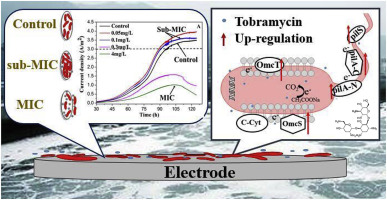当前位置:
X-MOL 学术
›
Water Res.
›
论文详情
Our official English website, www.x-mol.net, welcomes your feedback! (Note: you will need to create a separate account there.)
Subminimal inhibitory concentration (Sub-MIC) of antibiotic induces electroactive biofilm formation in bioelectrochemical systems
Water Research ( IF 12.8 ) Pub Date : 2017-08-29 , DOI: 10.1016/j.watres.2017.08.059 Lean Zhou , Tian Li , Jingkun An , Chengmei Liao , Nan Li , Xin Wang
Water Research ( IF 12.8 ) Pub Date : 2017-08-29 , DOI: 10.1016/j.watres.2017.08.059 Lean Zhou , Tian Li , Jingkun An , Chengmei Liao , Nan Li , Xin Wang

|
Electroactive biofilms (EABs) generated from mixed inocula are attractive due to their unique direct extracellular electron transfer abilities and potential use in water pollution control. In this study, for the first time, we identified a chemical that can be used for EAB regulation (both inhibition and promotion). We confirmed that tobramycin, an antibiotic previously demonstrated to inhibit the activity of EABs, is an agonist of EAB formation at subminimal inhibitory concentrations (sub-MICs). Compared to the control, at tobramycin concentrations of 0.05 (1/80 MIC) and 0.1 mg/L (1/40 MIC), the time required to reach 3 A/m2 was shorter, and the limiting current densities increased by 17%. The enhanced EAB activity was primarily attributed to the 50% increase in biomass density from 289 ± 21 to 434 ± 12 μg protein/cm2 and the increased biofilm thickness from 28 ± 1 to 37 ± 0.5 μm. Geobacter species in the microbial communities were selectively increased from 76% to 82%, and their abundance was estimated to increase by 1.63-fold. The accelerated growth was further confirmed using the model strain G. sulfurreducens PCA. Transcriptomic analysis revealed that 0.05 mg/L of tobramycin led to a significant upregulation of genes related to cytochromes and the type IV pilus, suggesting a possible mechanism for the observed current enhancement. These findings extend our knowledge of the regulation of EAB formation by antibiotics and the selective enrichment of Geobacter from a mixed culture, with broader implications on the potential impact of trace antibiotics on the dissimilatory metal reduction process in water environment.
中文翻译:

抗生素的最小抑菌浓度(Sub-MIC)诱导生物电化学系统中电活性生物膜的形成
由混合接种物产生的电活性生物膜(EAB)具有吸引力,因为它们具有独特的直接细胞外电子转移能力以及在水污染控制中的潜在用途。在这项研究中,我们首次确定了可用于EAB调节的化学物质(抑制和促进)。我们证实妥布霉素是一种以前被证明可以抑制EABs活性的抗生素,在最小抑制浓度(sub-MICs)下是EAB形成的激动剂。与对照相比,在妥布霉素浓度为0.05(1/80 MIC)和0.1 mg / L(1/40 MIC)的情况下,达到3 A / m 2所需的时间较短,极限电流密度增加了17%。EAB活性增强主要归因于生物质密度从289±21增加到434±12μg蛋白/ cm 2 50%,生物膜厚度从28±1增加到37±0.5μm。Geobacter菌在微生物群落物种选择性地从76%提高到82%,以及它们的丰度,估计由1.63倍增加。使用模型菌株G.thioreducens进一步证实了加速生长PCA。转录组学分析显示,0.05 mg / L的妥布霉素导致与细胞色素和IV型菌毛有关的基因显着上调,这表明观察到的电流增强的可能机制。这些发现扩展了我们对抗生素对EAB形成的调控以及混合培养中土细菌的选择性富集的知识,对痕量抗生素对水环境中异化金属还原过程的潜在影响具有更广泛的影响。
更新日期:2017-08-30
中文翻译:

抗生素的最小抑菌浓度(Sub-MIC)诱导生物电化学系统中电活性生物膜的形成
由混合接种物产生的电活性生物膜(EAB)具有吸引力,因为它们具有独特的直接细胞外电子转移能力以及在水污染控制中的潜在用途。在这项研究中,我们首次确定了可用于EAB调节的化学物质(抑制和促进)。我们证实妥布霉素是一种以前被证明可以抑制EABs活性的抗生素,在最小抑制浓度(sub-MICs)下是EAB形成的激动剂。与对照相比,在妥布霉素浓度为0.05(1/80 MIC)和0.1 mg / L(1/40 MIC)的情况下,达到3 A / m 2所需的时间较短,极限电流密度增加了17%。EAB活性增强主要归因于生物质密度从289±21增加到434±12μg蛋白/ cm 2 50%,生物膜厚度从28±1增加到37±0.5μm。Geobacter菌在微生物群落物种选择性地从76%提高到82%,以及它们的丰度,估计由1.63倍增加。使用模型菌株G.thioreducens进一步证实了加速生长PCA。转录组学分析显示,0.05 mg / L的妥布霉素导致与细胞色素和IV型菌毛有关的基因显着上调,这表明观察到的电流增强的可能机制。这些发现扩展了我们对抗生素对EAB形成的调控以及混合培养中土细菌的选择性富集的知识,对痕量抗生素对水环境中异化金属还原过程的潜在影响具有更广泛的影响。


























 京公网安备 11010802027423号
京公网安备 11010802027423号